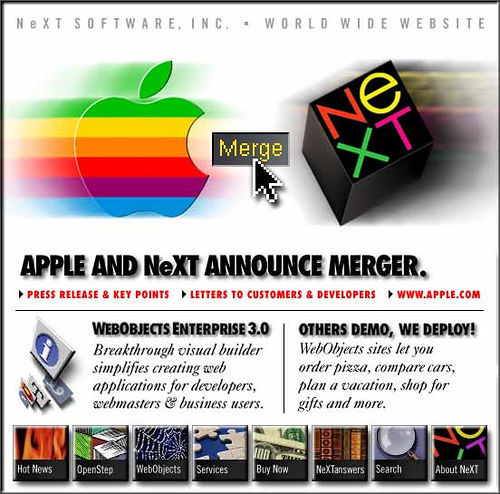My mini-series on NeXT Computer:
Installment 1: On the Creation of NeXT
Installment 2: NeXT: The Hardware
Installment 3: NeXT: The Software
Installment 4: NeXT: The Apple Purchase
Installment 5: Why Did NeXT Fail?

I don’t think the importance of NeXT being purchased by Apple can be overstated.
With a single purchase, Apple gained a stable, mature OS, lots of underpinning technology and Steven P. Jobs.
Apple’s Failure to (Re)Launch
After launching System 7 — and handing it out to clone makers — Apple looked forward to a new Mac OS.
(It ended up being named Mac OS 8 to break the contracts with clone makers.)
Apple’s OS was in trouble. The writing on the wall was in the form of Windows 95. It brought tons of features to the market that Apple could only dream about.
To try to meet Microsoft, Apple launched the Copland project. Now, Copland is worthy of its own lengthy post, but I won’t get too far in to it here. In short, it was a project to bring things like protected memory and preemptive multitasking to the Mac OS. By 1996, it was clear things weren’t working out very well.
However, while Mac OS 8 did get out the door, it wasn’t the technical platform Apple needed to survive, so Apple started to shop around for an OS before it was ever released. Apple looked at several options, including BeOS:[1]
Apple CEO Gil Amelio started negotiations to buy Be Inc., but negotiations stalled when Be CEO Jean-Louis Gassée wanted $200 million; Apple was unwilling to offer any more than $125 million.
So Apple turned to NeXT.
The NeXT Purchase
On Dec. 20, 1996, Apple announced that it had purchased NeXT Computer:
Apple Computer, Inc. today announced its intention to purchase NeXT Software Inc., in a friendly acquisition for $400 million. Pending regulatory approvals, all NeXT products, services, and technology research will become part of Apple Computer, Inc. As part of the agreement, Steve Jobs, Chairman and CEO of NeXT Software, will return to Apple–the company he co-founded in 1976–reporting to Dr. Gilbert F. Amelio, Apple’s Chairman and CEO.
The acquisition will bring together Apple’s and NeXT’s innovative and complementary technology portfolios and significantly strengthens Apple’s position as a company advancing industry standards. Apple’s leadership in ease-of-use and multimedia solutions will be married to NeXT’s strengths in development software and operating environments for both the enterprise and Internet markets. NeXT’s object oriented software development products will contribute to Apple’s goal of creating a differentiated and profitable software business, with a wide range of products for enterprise, business, education, and home markets.
(You can download the entire statement as PDF here.)
Gil Amelio wrote this in his letter concerning the NeXT purchase:
A little background as to why we chose NeXT: As we looked at various partners for our operating system development, we discovered that Apple and NeXT had surprisingly complementary products, technologies, and services. In fact, the more we looked at the two companies, the more we realized that we each were strong where the other faced challenges, and in many ways we filled in the blanks in each other’s strategies. For example, Apple needed a truly modern operating system and NeXT had an exceptional operating system with modern services and API’s. At the same time, NeXT needed a high-volume installed base and Apple — one of the world’s largest personal computer manufacturers — has sold more than 26 million Macintosh systems.
As an Apple customer, this move is extremely important because it acts as an emblem of the new types of products, technologies, and development philosophy I’m bringing to Apple. In this new approach, the “Not Invented Here” syndrome has been banished far beyond the horizons of our vision. Apple will be open to new technologies, and where they’re developed doesn’t matter. In this new era, we will not be an island in the industry; but rather build a bridge to the center of an open standards world based on industry alliances.
The Response
Not everyone was thrilled with the acquisition. The Sun/Solaris community was concerned, as were BeOS fans.
Their fears were well-founded, as it turns out.
CNET had a great article sharing the thoughts of several industry members and pundits.
From NeXTStep to OS X
The purchase gave Apple lots of things. Most importantly, however, it gave it an operating system:
Apple’s exhaustive research in operating system design, led the company to conclude that NeXTStep maturity, networking, customer and developer acceptance, multi- tasking, protected memory, and scalability from portable to server-level products make it the clear choice for integration into the next major revision of Mac OS. Apple believes that the integration of NeXTStep technology in future versions of Mac OS will result in a robust, next generation OS that provides customers and developers with a multimedia-rich and Internet-savvy platform.
In March 1999, Apple released Mac OS X Server 1.0, it was based on OpenStep, but had the Platinum interface from Mac OS. This OS was based on the Rhapsody project, the project inside Apple to merge the old Mac OS with NeXT’s technology.
Mac OS X Server 1.0 included the ability to run Mac OS 8.5.1 in emulation, to support “classic” apps. This technology would re-appear in Mac OS X.
The rest of the story is well known. In 2001, Apple announced Mac OS X, which included lots of NeXT technology. To this day, OS X runs on the foundations built at NeXT two decades ago.
- Ironically, BeOS was the brainchild of Jean-Louis Gassée, who ran the Macintosh team after Steve Jobs left Apple. ↩